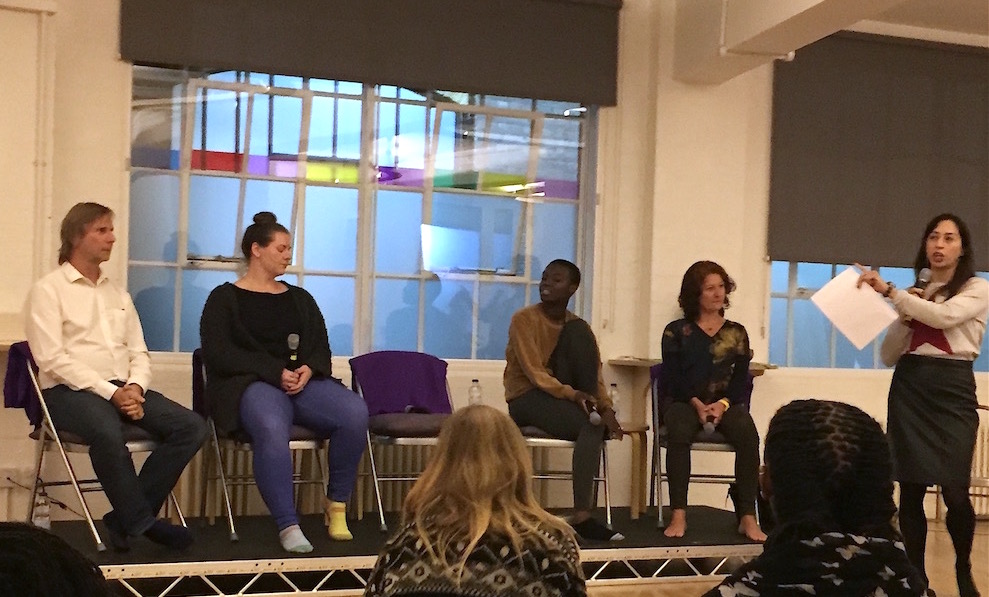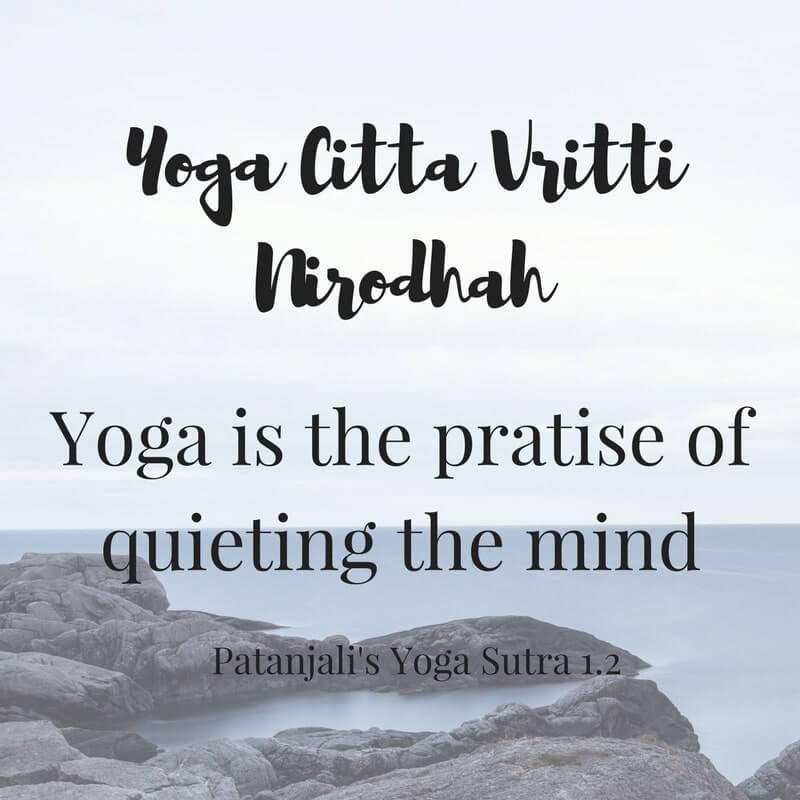Last Monday I attended a teacher’s symposium on the topic “The Diversity Problem in Yoga” at TriYoga’s Camden studio. The premises of the talk was to find out (as much as possible) why yoga in the Western world, today being more popular and mainstream than ever, seems to practiced by a very homogenous set of people, often identified as a white, able-bodied, middle-class women. Why is it that whilst the population in general is getting more and more overweight and aging and the racial and religious diversities present around us, the yoga community as a whole does not necessary reflect these realities?
“Are we as yoga schools, teachers and students reinforcing existing barriers and divisions, and how can we actively dissolve them? How can we create a more inclusive space for everyone no matter their size, their ethnicity, their income and their gender?”
The panellists of the evening included Jonathan Sattin who founded the first TriYoga studio in 2000, Dana Falsetti, a body positive yoga teacher, Corrie Ananda Preece and Isa-Welly Locoh-Donou who teach Mysore and Pilates & Barre respectively at TriYoga and Frederique Sardais who was the first UK teacher to specialise in Adaptive Yoga, a type of specialist classes for people living with disability and limited movement.

Kindly note that this post is not a transliteration of the 90 minute symposium. My aim is to bring forwards some of the many questions, challenges, various points of views and suggestions for improvement that came up during the discussion. I offer my take on these where I see I have something to add. The discussion was recorded and to hear it full you can head to TriYoga’s Facebook page. The photo credit of the two pictures of the panellists goes to TriYoga who kindly gave me the permission to use their photos.
I want to also highlight before going any further that we all have very different experiences so what is said below is obviously not the universal truth about yoga studios and communities. You do not need to agree with all/anything what follows below – for instance during my over 10 years of regular practise I have more often than not seen people of all ages, from six year old kids to the veterans for WW2, being represented in yoga classes. However this is not the experience many share and I accept age, as an example, can be seen an issue associated with the conversation about diversity in yoga.
For me when something is presented as an issue that needs correction of sorts there are few fundamental questions that needs to be asked right at the beginning, in order to not get lost in the conversation.
- What makes us say there is a diversity problem?
- What do we believe (or know) are the reasons for this problem?
- What does the ideal (or at least improved) situation look like?
- Is there something being already done to improve the situation and how is that working (or not and why not?)
In no particular order, here are some of the reasons why we can say there is a diversity problem in yoga:
- There seems to be considerably less of yoga teachers and yoga practitioners of colour than there are white practitioners.
- There seems to be a lot more women in your average yoga class than there are men. The same goes for yoga teachers.
- There seems to be are lot more people who are of “normal” weight if not “slim” practising yoga than people who are overweight.
- Most people we see in a regular yoga class are fairly able bodied, although naturally not all disabilities – starting from the mental ones – are visible to others.
- Yoga also seems to be very much associated with youth, and more specifically with females in their 20s and 30s, despite the fact the Western population keeps on aging.
In the birth country of yoga, India, yoga transcends all classes and casts. Where does this diversity problem in the West come from then?
A big part of modern yoga’s diversity issue can be traced (or, at least we like to trace it) to the popular imagery: From the covers and features in Yoga Journal to lululemon and Sweaty Betty look books, the white skinny (often very flexible) female is ever present in the photos. Most gyms and yoga studios, whether consciously or not, perpetuate the same imagery. You can talk as much as you want about the welcoming and open atmosphere of a studio in marketing materials but if everybody working there looks more or less that same (and you do not not look like that), this IS part of the reason yoga can be seen as homogenous, or even elitist, activity.
Now is this because of the image some studios want to portray, or is it due to a form of unconscious bias? I am sure there is an element of the both. However, at this day and age, especially when we are talking about an activity that is all about inclusiveness and openness, it feels appropriate to remind us all that the word “yoga” itself means “union.” Feel free to see the irony…
If there is a genuine will to improve things from what is seen as not the ideal situation, the only way forward for all of those involved in the community, as businesses and practitioners, is to fairly and squarely realise the current state and take concrete actions to move forward. As an example of this, TriYoga stated on their Facebook page few days ago ”We recognise (…) that some of our marketing material in the past may not have reflected our intention to be inclusive and we are working to change that.”

That is a big and very noble statement. Being inclusive is hard work, and maybe creating a studio space where nobody, EVER, would feel excluded is not even possible. Yet, by bringing awareness and mindfulness to our thoughts and actions in regards to the words we use, to the assumptions we make (or try not to make) and even to our body language, can take us a long way.
Finally, the financial barriers to yoga are also very real. Ten pounds (or euros) a yoga class can be a lot to pay for a single mother with three kids, for a student, or just for anybody living in an expensive city on a low salary. Many studios charge even more than a ten pounds for a drop-in class at peak-hours. It is true that many places have community classes that are priced on a lower level. However, as one of the audience members on Monday pointed out, if these community classes take place in the middle of the day when most people are working, their impact does not go very far, despite the beautiful intentions. On the other side of the coin, yoga teachers need a make a living too, to provide for the family, pay for the bills and maybe even put something towards the pension fund.
Where does the balance lie with between the yoga studios running as a business, the teachers sharing their passion and the people who can and could benefit from the practise we want to share and offer?
What do we want then and whatever it is, do we know if it already exists somewhere?
Any of the above said does not mean that all the white slim-ish middleclass women should hang their head in shame. None of us chose the body we were born in and nobody can be spared of illnesses and misfortunes of life just because of a socio-economic status. But a lot can be done just through education, having an awareness of the many realities that exist in the communities and checking if our assumptions of the realities are actually founded in the truth.
What came up few times in the discussion on Monday was the feeling of being an outsider, or not belonging to “yoga.” This can come from various factors: One can feel like his/her body shape is not represented and therefore accepted in a class, or have a teacher who does not know how to teach different body shapes and conditions through offering props and modifications. Yoga can feel very “white” activity, or a particular studio can just have a vibe that does not attract. The first time stepping into a yoga class can be a very intimating situation for anybody, so all of us can imagine how this is easily made worse by not feeling welcomed or fitting in for whatever reason.
It is also healthy to remember that yoga is much more than the asana practise. Meditation, breathing practises and studying the philosophy are also yoga. The Sutra 1.2 reminds us that yoga is about controlling the fluctuations of the mind. Reducing yoga to represent just asana is also an assumption to be challenged. It is important for all of us as practitioners and teachers to be open to all sorts of questions and show by example how yoga works for everybody, and in every day life. Just the other day I heard a friend saying in all seriousness (in my own kitchen of all places) how “I’d be too scared to go to a yoga class because apparently all those movements make you fart.” I did my best to reassure that more often than not, farting does NOT happen, and even if it does, it is ok (but really, it is rare! I swear!) Yoga is actually very simple physically – it is our minds that play on us to think otherwise. And that mind stuff – well, lets refer back to Sutra 1.2.

Like I said in the beginning, of course there are plenty of people who have never seen or viewed yoga as something alienating, “not for them” or lacking diversity. Yoga is lived and practised in variety of places, outside the traditional shala or the modern studio. Yoga exists in community halls and in the clubrooms owned by various religions. Yoga is featured as an integral part of weekly training for athletes ranging from rugby to ice hockey to martial arts. Yoga classes are offered in ballet schools and physiotherapy clinics, for children at schools and for elderly people in the form of chair yoga. Of course there is progress to be made but there is equally a lot of evidence to demonstrate that yoga truly can work for all, regardless age, race, religion and gender.
The way I see it, the conversation about the lack of diversity in yoga teaches us about the opportunities there are out there to reach out and connect with the community. Think about it and share your thoughts. What is yoga to you and would you like to see more diversity in yoga? What does that diversity would look like to you? Join the conversation in the comments below!
NB The featured image of this post is not my own.
